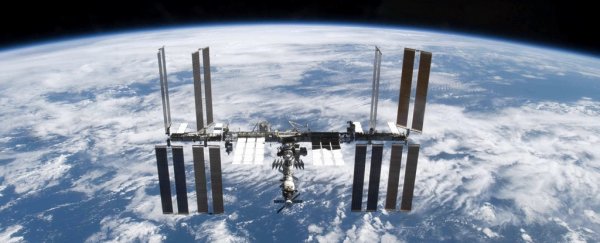Scientists on board the International Space Station (ISS) have discovered living bacteria clinging to the orbital facility's external surface, according to a prominent Russian cosmonaut.
Anton Shkaplerov, who will return to the ISS next month, says cotton swabs wiped over the exterior of the station's Russian segment revealed an unidentified life-form that has already been sent back to Earth for scientific analysis.
"[I]t turns out that somehow these swabs reveal bacteria that were absent during the launch of the ISS module," Shkaplerov told Russian news agency TASS.
"That is, they have come from outer space and settled along the external surface. They are being studied so far and it seems that they pose no danger."
According to Shkaplerov, the samples were taken during extravehicular activity, probing obscure areas around the ISS exterior and places where fuel waste accumulates from discharge of the station's engines.
What makes the discovery potentially exciting is that at present we've been given no explanation for just how the organisms got there – nor what exactly they are.
Given the ambiguous nature of Shkaplerov's comments, many media observers are speculating this could be the first known "proof of alien life".
But before we get over-excited here, there are some good reasons to think the bacteria probably aren't extraterrestrial visitors.
This is not the first time Roscosmos, the Russian space agency, has claimed to have found evidence of microbes on the outside of the ISS - but all former discoveries ended up having an earthly origin.
Earlier in the year, Russian cosmonauts detailed the findings of an extensive experiment lasting between 2010 and 2016, in which swabs were taken from outside the ISS and later analysed.
The samples revealed a number of different microorganisms, including a kind of bacterial sea plankton and a type of soil microbe usually found on the island of Madagascar.
As for how these land- and sea-dwelling organisms find their way into space and end up hitchhiking a ride on the ISS, Russian researchers have suggested the voyage could be made via ionosphere lift – in which rising air currents transport matter to the upper reaches of Earth's atmosphere.
Of course, another hypothesis is that the ISS exterior just got contaminated somehow from people, equipment, or crafts launched from Earth to the station.
This wouldn't be too surprising, given the station is said to be riddled with germs and microbe colonies due to all the different astronauts and cosmonauts that have lived within the facility over the years.
Figuring out how stowaway bacteria like this handles life in space is an important area of research – given the implications for future human exploration of the Solar System – and especially since we already know at least some kinds of dangerous bugs actually seem to thrive in microgravity.
Until further analysis of the new bacteria found on the ISS is complete, we won't know what it is, and won't be able to hypothesise on how it got there.
But given these things is already here on Earth and being tested, we're likely to get our answers soon. Stay tuned.
